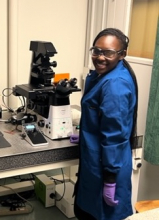
University:
Jackson State University
Major:
Biology Pre-Pharmacy
Mentor(s):
Aria Ghasemizadeh
Faculty Sponsor(s):
Cyrus Safinya
Faculty Sponsor's Department(s):
Materials
Project Title:
Synthesis of Amphipathic Peptides and their Conjugation to PEG-lipids for the Improved Drug Delivery
Project Description:
The problem with current treatments for chronic diseases such as cancer, is that they result in mild to severe side effects, where the treatment affects the healthy cells as well as the “sick” cells. Our goal is to form a structure that will aid in effectively delivering drugs and other molecules to and throughout a targeted cell. Amphipathic peptides (APs) have destabilization properties that can aid in this goal by assembling together and creating bilayer-spanning pores. Peptides are simply a shorter protein chain (<50). These pores will allow the passage of important molecules through cell membranes. The ideal variant of the bee venom peptide, melittin, is a 26-residue peptide called MelP5. MelP5 is appealing because it forms those stable and large pores needed to successfully progress the drug delivery. In our experiments we will explore the potential of two structures: amphipathic peptide(AP)-polyethyleneglycol(PEG)-lipid and double PEG-lipid. Due to instrument limitations, the peptide synthesis of the AP has not been performed, so this study will focus primarily on the PEG building block synthesis. We will do this by synthesizing PEG so that each end will be reactive enough to connect to both the AP and the lipid for the AP-PEG-lipid, and reactive enough to connect both PEGs to a lipid. The PEG that was synthesized for the AP-PEG-lipid structure was successful in transforming it to an amine-PEG. Therefore, it is now ready for the next steps in creating the actual conjugate structure. Currently, the synthesis for the double PEG has shown some impurities. Before moving on to the next steps in the doublePEG-lipid structure, we’re trying to figure out what those impurities are with trials of thin layer chromatography. In future studies, the intent is to efficiently synthesize and fuse these structures with prospects to test this delivery system in an actual cell.
